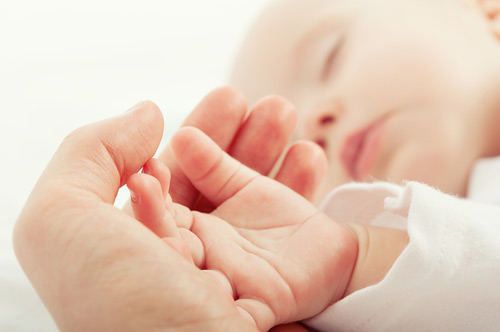Caring For Your Baby

[Adapted from The Expectant Parents' Companion, by Kathleen Huggins. Copyright © 2008, used by permission of The Harvard Common Press.]
Baby-Care Basics
There are a lot of little items that you will want to consider getting for the day-to-day care of your baby.
Pacifiers
These are controversial. If pacifiers are used frequently in the early weeks, a baby may have trouble learning to breastfeed. Also, studies have linked pacifier use with ear infections. But babies need a lot of sucking time, and those who aren't given pacifiers or the breast whenever they fuss may come to depend on their fingers or thumbs. Some think that finger- or thumb-sucking is a harder habit to break than sucking on a pacifier.
If you decide to try a pacifier, find one that is made of silicone and orthodontically shaped - that is, shaped to conform to the interior of the mouth.
Bath Items
Baby Bathtub. Some parents make do by bathing the baby in the kitchen sink or bathing along with the baby in a regular bathtub, but others buy a special little tub for the early months. If you decide to buy one, look for a skid-resistance surface, and also for a drain in the bottom so you won't strain and splash yourself when you empty the tub.
Baby Bath Pad. If you decide to wash the baby in the sink, you might want one of these to keep the baby from slipping. Avoid the kind that are huge sponges; they are difficult to dry, and they breed mold and bacteria.
Bath Seats And Rings. Used when a baby can sit up but can't be trusted to stay up, these give parents a false sense of security. Babies have drowned because their parents have left them unattended in these devices.
Baby Soap. This tends to be milder than other soaps, with less fragrance and without antibacterial chemicals or abrasives. Mild soaps not especially intended for babies, such as Neutrogena and Dove, are usually kind to a young baby's skin.
Baby Shampoo. Generally milder than other shampoos, baby shampoo doesn't sting if it gets in the eyes.

Diapering Items
Baby Wipes. Commercially made disposable wipes are popular, but the perfumes and other chemicals can irritate a baby's skin. Chemical-free baby wipes are available but more expensive. Some parents use soft, dry disposable wipes such as Quickables; these are used in many hospitals and are available through medical suppliers. Other parents use Viva paper towels, which are both soft and strong. You cut the roll in half or quarters with a serrated knife, pull out the tube, and then dampen the towels with water or baby oil.
You can, of course, do without disposable wipes and use cloth instead. Baby washclothes work well; so does cotton flannel or terry, cut into squares. Just moisten the cloths before using them. If you're using cloth diapers, wash the wipes along with the diapers.
Diaper-Rash Ointment. Because urine and acid stools irritate the skin, many babies get diaper rash. A petroleum ointment such as A&D can be used every day to protect your baby's skin. To protect a baby who is especially prone to rash, or to treat an existing rash, use an ointment that contains zinc oxide, a longer-lasting barrier than petroleum. A&D, Balmex, and Desitin all make zinc-oxide ointments.
Medical Items
Included here are first-aid supplies, many of which you may have in your home already. Note: Syrup of ipecac and liquefied charcoal are no longer recommended for home use. In the event of poisoning, call a poison-control center.
Cotton Swabs and Alcohol. These are to care for the umbilical cord stump. Swab the cord with alcohol at most diaper changes.
Thermometer. The best type is digital. Glass thermometers are no longer recommended because of the danger of leaking mercury; besides, digital thermometers work faster and are much easier to read. Digital thermometers are used with disposable plastic sheaths. A young baby's temperature is taken rectally; you lay the baby face down across your lap and insert the lubricated thermometer 1/2 inch into the rectum. When a baby reaches three months of age, you can take his temperature by putting the thermometer in his armpit and holding his arm against his side.
Petroleum Jelly. This is used as a lubricant for taking a rectal temperature.
Nasal Aspirator and Saline Drops. When your baby has a stuffy nose, you can loosen the mucus by dropping saline solution into the nose. Then you can gently remove the mucus with a small nasal aspirator, a rubber bulb with a narrow tip.
Infant-Strength Acetaminophen, Liquid or Suppositories. This is a pain reliever and fever reducer.
Calibrated Dropper and Measuring-Pouring Spoon. You'll need these for liquid medicines
Humidifier or Vaporizer. These help to make breathing easier for baby during respiratory illnesses. Cool-mist humidifiers are now considered safe only if they are ultrasonic, have a particle filter, or are used with distilled water. Vaporizers, which produce a hot vapor, are generally preferred over humidifiers.
Ice Packs. These are handy for a bang on the head.
Hydrogen Peroxide. A mild antiseptic, hydrogen peroxide is useful for cleaning cuts and scrapes.
Adhesive Bandages You'll use these for any number of mishaps.
Gauze Pads and First-Aid Tape. These items are necessary for covering larger areas of skin.
Antibiotic Ointment. An important item to have on hand, antibiotic ointment can be applied to cuts and scrapes to help prevent infection.
Tweezers. You'll need these to remove splinters or stingers.
First-Aid Book. A first-aid book is an important resource to keep handy.
Emergency Contact List. Make sure to include a poison-control number.
Grooming Items
Fine-Toothed Comb and Soft Brush. Although you could use a regular comb and brush, a fine-toothed comb is better for fine baby hair, and a soft brush won't irritate baby's sensitive scalp.
Manicure Items. You can use baby nail clippers or scissors to trim fingernails and toenails, or you can file the baby's nails with an emery board.
Baby Oil. This is good for massage and also for treating cradle cap, a crusty layer that forms on many babies' scalps because the skin grows faster than it falls off. Massage a few drops of oil into the scalp, and then use a fine-toothed comb or a dry terry wash-cloth to gently rub the flakes away.
 PREGNANCY
PREGNANCY  GIVING BIRTH
GIVING BIRTH  BABY CARE
BABY CARE  HEALTH & SAFETY
HEALTH & SAFETY  FUN STUFF
FUN STUFF  FAMILY
FAMILY 